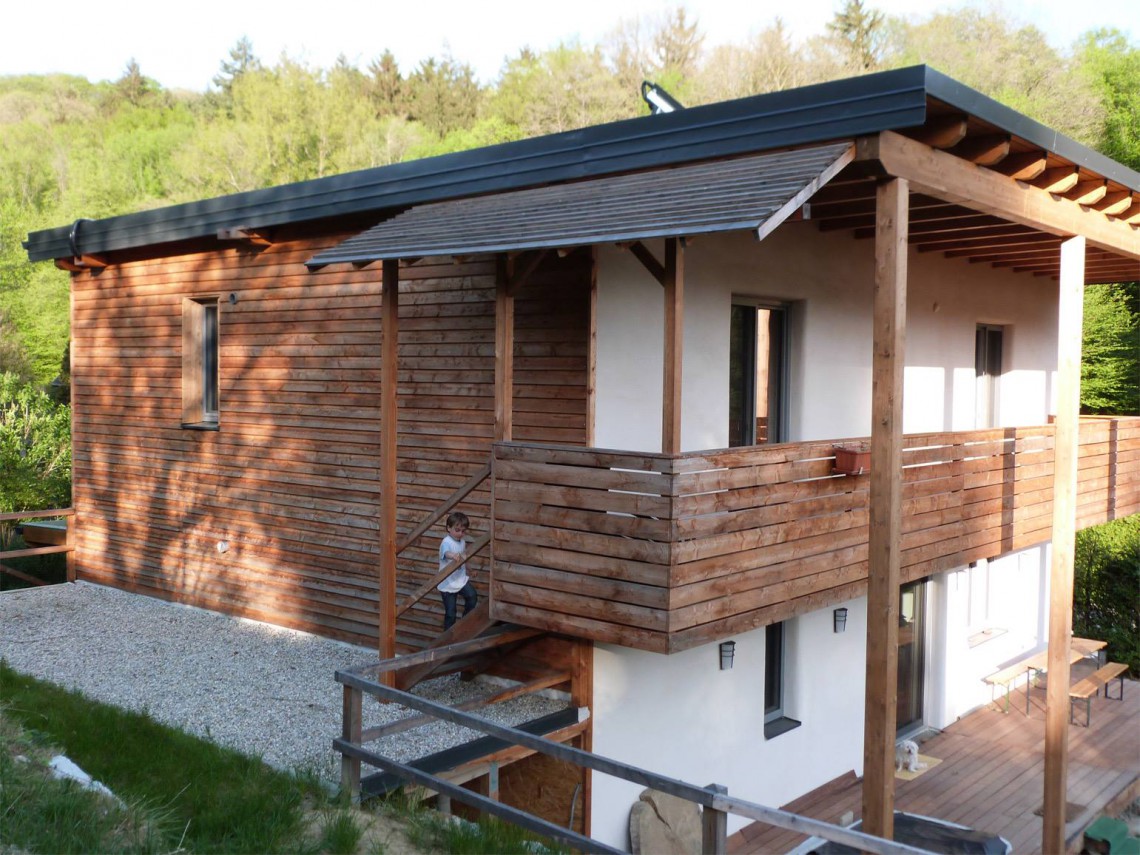Fam. Herler: Our house is built using the classic wooden post and beam method with infill technology. We use 35 cm thick straw bales, which, clamped between 2 wooden posts each, and together with 24 cm of flax in the floor, result in a good low-energy house (32 KWh/m2/year). An optimal vapour pressure gradient in the wall from the inside to the outside is achieved by planking with OSB boards on the inside and DWD boards on the outside. The inner board provides horizontal stiffness and has 60 times the vapour pressure resistance of the outer board (µ-value of 140-200), which also serves as a windbreak. The house is thus open to diffusion and does not need any plastic vapour barrier. We deliberately decided against a passive house with controlled ventilation and a geothermal heat pump, as a central and visible fireplace is very important for our sense of well-being and the least possible dependence on technology is a declared goal. Therefore, we will heat our house with a water-bearing stove, which together with solar water heating will feed a buffer tank. Additional heating elements are planned in the form of underfloor or wall heating on the ground floor and in the bathroom on the upper floor. The bedrooms on the upper floor are heated only by convection from the stove. Wall heating ensures optimal temperature distribution in the room and is therefore also highly recommended in terms of building biology. They keep the walls dry and increase the wall temperature (which is decisive for the feeling of warmth) without overheating the air (which remains cooler and more humid). Info at www.unserhauswaechstnach.org.
Fam. Herler: Unser Haus wird in der klassischen Holzständermethode mit infill-Technik gebaut. Es kommen 35 cm starke Strohballen zum Einsatz, die, zwischen je 2 Holzständer eingeklemmt, und gemeinsam mit 24 cm Flachs im Boden zu einem guten Niedrigenergiehaus (32 KWh/m2/Jahr) führen. Ein optimales Dampfdruckgefälle in der Wand von innen nach außen wird durch Beplankung mit OSB-Platten innen und DWD-Platten außen erreicht. Die innere Platte sorgt für die Horizontalsteifigkeit und hat einen 60-fach höheren Dampfdruckwiderstand als die äußere (µ-Wert von 140–200), die auch als Windbremse dient. Das Haus ist somit diffusionsoffen und kommt ohne jede Kunststoff-Dampfbremse aus. Wir haben uns bewusst gegen ein Passivhaus mit kontrollierter Wohnraumlüftung und Erdwärmepumpe entschieden, da uns eine zentrale und sichtbare Feuerstelle sehr wichtig für das Wohlbehagen ist und geringstmögliche Technikabhängigkeit ein erklärtes Ziel ist. Daher werden wir unser Haus mit einem wasserführenden Kaminofen beheizen, welcher gemeinsam mit solarer Warmwasserbereitung einen Pufferspeicher beschickt. Zusätzliche Heizungselemente sind in Form einer Fußboden- bzw. Wandheizung im Erdgeschoss und im Bad im OG geplant. Die Schlafräume im OG werden nur über die Konvektion des Ofens erwärmt. Wandheizungen sorgen für eine optimale Temperaturverteilung im Raum und sind daher auch im Sinne der Baubiologie sehr empfehlenswert. Sie halten die Wände trocken und erhöhen die Wandtemperatur (die für das Wärmeempfinden ausschlaggebend ist) ohne die Luft zu überheizen (diese bleibt kühler und feuchter). Infos auf www.unserhauswaechstnach.org.

